Finalist proposal for a new elementary school in Shefford - Lab-École Architectural Design Competition
Proposal developed in consortium with the architect Alexandre Landry for the new Shefford Primary School, which was a finalist in the two-step Lab-École architecture competition. To look at the complete proposal, including the presentation panels (Stage 1 and 2 tabs), check out the Canadian Competitions Catalogue.
Location
Shefford, Québec
Partner
Alexandre Landry Architecte
Scale
4 925 m²
Completion
2019
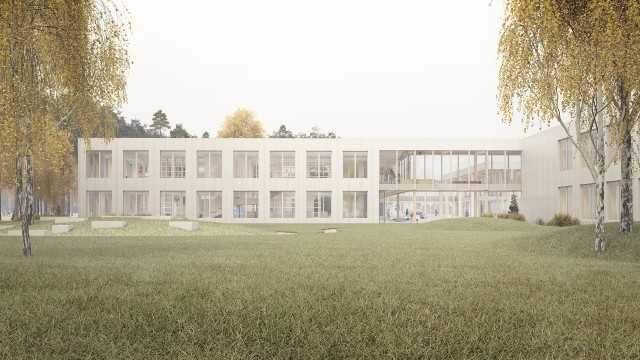
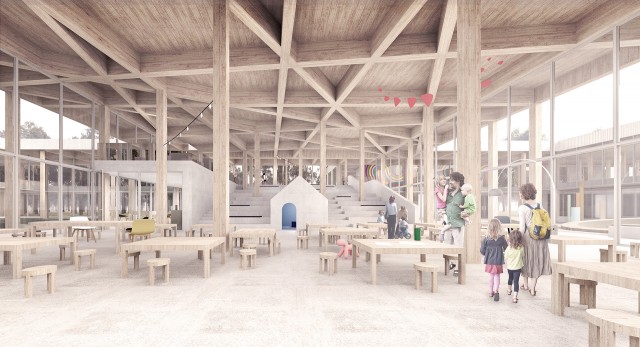
The Glade Primary School
At the Glade Primary School, the architecture is combined with the educational purpose of nature, while emphasizing the project's inclusion in the community fabric and its forest environment.
As a whole, the school values play, discovery and outdoor learning by taking advantage of the site’s natural elements. The overall design respects the diversity of the ecosystems and the protection of the natural heritage by minimizing the human footprint and by offering experiences adapted to each location.
The glade-courtyard
The project is articulated around the existing clearing at the heart of the site. It is from this center that a permeable architecture towards the tranquility of the forest unfolds. A covered path, a footbridge, and pavilions gravitate around this glade-courtyard, a public space that is accessible to both schoolchildren and the community at different times of the day. In this place, activity, movement, sharing and light converge.
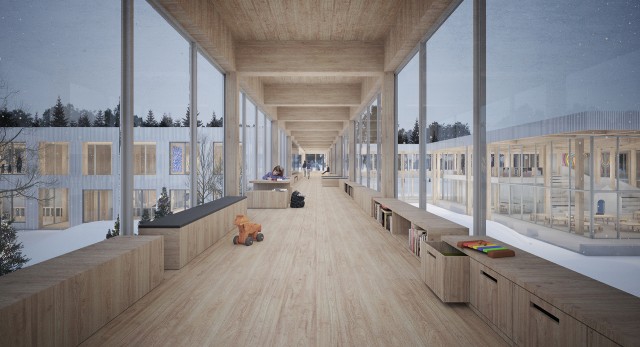
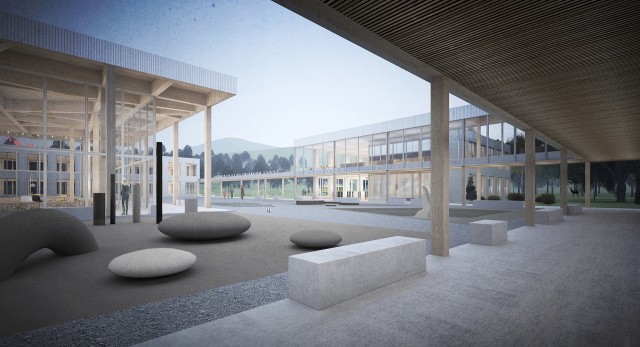
The covered path
The covered path is a continuous porch linking all the pavilions. A real threshold between the courtyard and the building, it surrounds the courtyard and allows a soft transition between the exterior and the interior. It forms an uninterrupted protected path in all seasons, punctuated by concrete benches on which the schoolchildren can sit down for lunch. In the spirit of a "school without shoes", this path finds its echo in the footbridge on the upper floor. Without obstacles, it allows universal access to all the key spaces of the school on this level.
The footbridge
The footbridge provides a free circulation in which movable or integrated seating, as well as fragments of an exploded library create opportunities for learning. Its generous materiality, with the exposed structure and wood floor, makes it welcoming and warm. It offers views on a series of animated spaces as well as the natural environment. Throughout the day and year, this lived-in path is a lively place, punctuated by spaces for socializing and contemplation.
The pavilions in the forest
Surrounded by forest, the teaching pavilions offer a privileged contact with the outside through loggias dedicated to each class. These loggias open onto outdoor spaces that are half-courtyard, half-forest, located between the pavilions and can accommodate outdoor classes.
The large openings punctuating the facade were designed so that the students can sit in their frame. These intimate sub-places are conducive to wonder and deepen the dialogue between the architecture and its forest environment.
The load-bearing structure concealed in the partitions creates column-free floor plans with great design flexibility, and the angled floor plan of the classrooms allows for a variety of uses. Designed to encourage calm and awaken inventiveness, the interiors are dotted with playful worlds of small scale. To invite movement, each pavilion is equipped with a bleacher space at the child's scale. This inhabited circulation that connects all the levels allows schoolchildren to admire the wooded area or the mountain, or for teachers to gather their students in small groups.
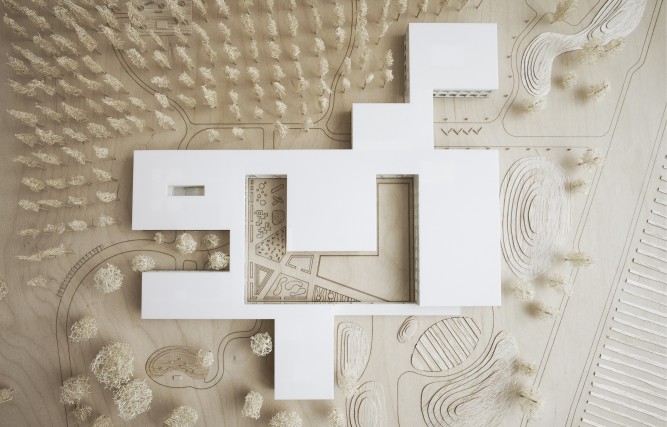

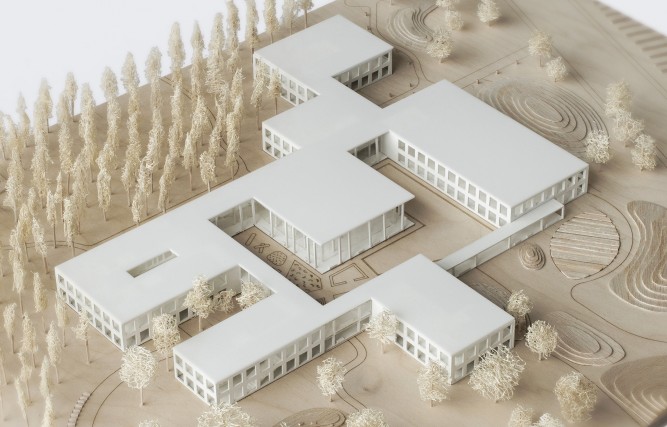
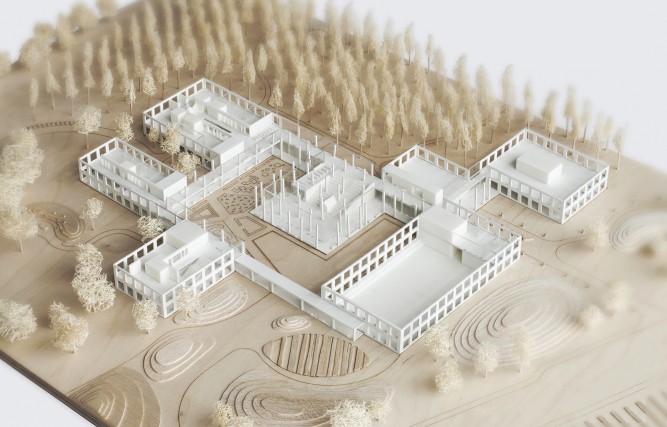
The mountain, a reassuring presence
An opening between the pavilions on the south side was created to make the mountain a part of the students' daily lives and provide natural light to the courtyard. The gap resulting from this opening creates a natural entrance through which the students will access the courtyard, before heading to the foyer or their respective pavilions. The view of the mountain will be particularly appreciated from the large community bleacher in the lunchroom, as well as on the route that will lead the children to the drop-off/pick up area at the end of the school day.
A welcoming school
The architecture encourages interaction between different user groups, including local residents and the socio-cultural community. To be more welcoming, functional and consolidated with the future community center, the gymnasium, the collective pavilion and the foyer have been grouped in a community hub overlooking the new street, a future active public area.
The foyer welcomes students and teachers and directs them to the dining hall, gym, or the various pavilions via the walkway. Community center visitors will have a dedicated entrance via a plaza on the new street.
The dining hall and gymnasium, places bustling with activity, offer panoramic views of the mountain and rub shoulders with the animation of the courtyard. Physical and visual links to the outdoors are encouraged from the gymnasium to extend learning onto the school grounds. Finally, the architecture of the dining hall is characterized by the warmth of the exposed structure and the continuity to the outdoors through pivot glass doors.

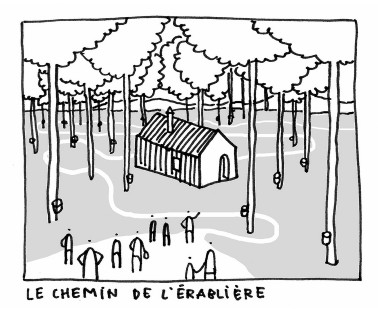

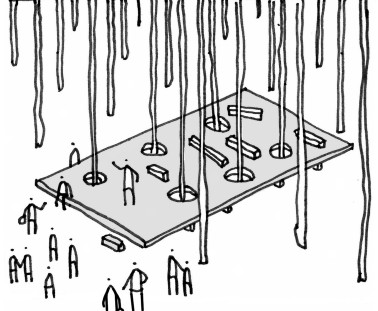
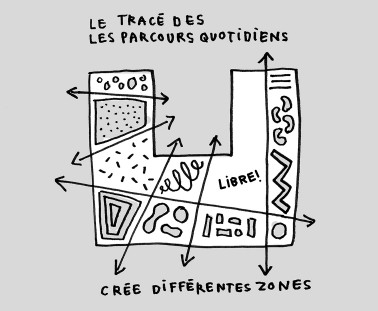

From the glade-courtyard to the forest: two worlds to discover
The contrasting worlds of the courtyard and the forest are expressed in their programs. Daily recreational activities take place in the controlled area of the courtyard, which is easily accessible and characterized by hard surfaces that are easy to maintain. Outside of the courtyard area are the more free-form activities in the wilderness. Physical activity is encouraged and there is bicycle storage.
The courtyard is the heart of the school and the heart of the community because it is located in the center of the site and is surrounded by school and community buildings. It offers various areas and surfaces for play and discovery, as well as innovative learning spaces that invite movement.
Outside, nature becomes a learning space. The interventions are minimal in order to preserve the natural heritage and let biodiversity flourish. There are trails and three forest zones: the maple grove, the birch forest and the pine forest, each offering an activity: an open learning structure reminiscent of the sugar shack, a small amphitheatre, a place of refuge and play, and a wooden platform at the foot of the trees to rest or hold an outdoor class.
Mounds reusing the earth excavated from the construction work create landforms on the periphery of the site. They become playgrounds in the landscape near the pastures. Sheep, goats and other animals graze on them, providing a soothing environment for children.
Sustainable development and building approach
The proposal is part of a sustainable development approach through the reuse of soils, the choice of materials and a bioclimatic architecture for an efficient management of energy resources. The orientation and layout of the pavilions as well as the double heights allow the deployment of passive systems, thus ensuring comfort all year round. Trees in front of the facades reduce heat islands and act as natural sunshades for the classrooms. Rainwater from the buildings, runoff, percolation or infiltration is also treated with care.
The materials used are healthy, easy to maintain, natural and local (wood, concrete, stone) and the orthogonal grid allows flexible spaces. As the pavilion typology requires a large quantity of materials for the exterior walls, economical construction strategies are deployed such as the use of traditional construction techniques and prefabrication for an efficient use of materials and labor.
We wish to thank to our collaborators Guillaume Leroux (Leroux+Cyr), Laurent Laframboise (Dupras Ledoux Inc.), Kim Marineau (Biodiversité conseil), Antoine Crépeau (WAA+) and Daniel Houle (Marchand Houle et associés).
We would also like to applaud the Lab-École initiative and the high quality of the projects submitted.